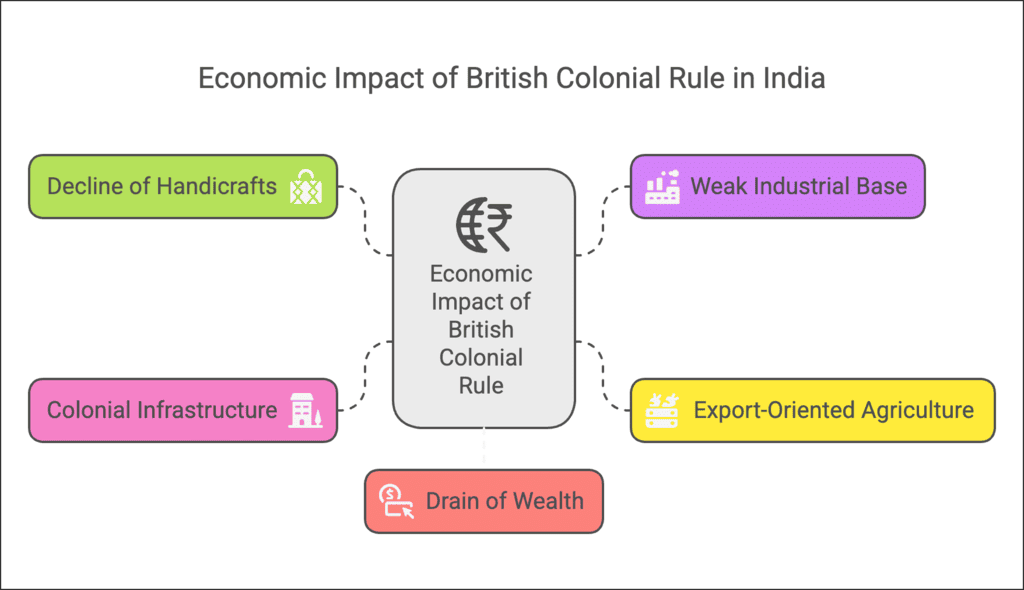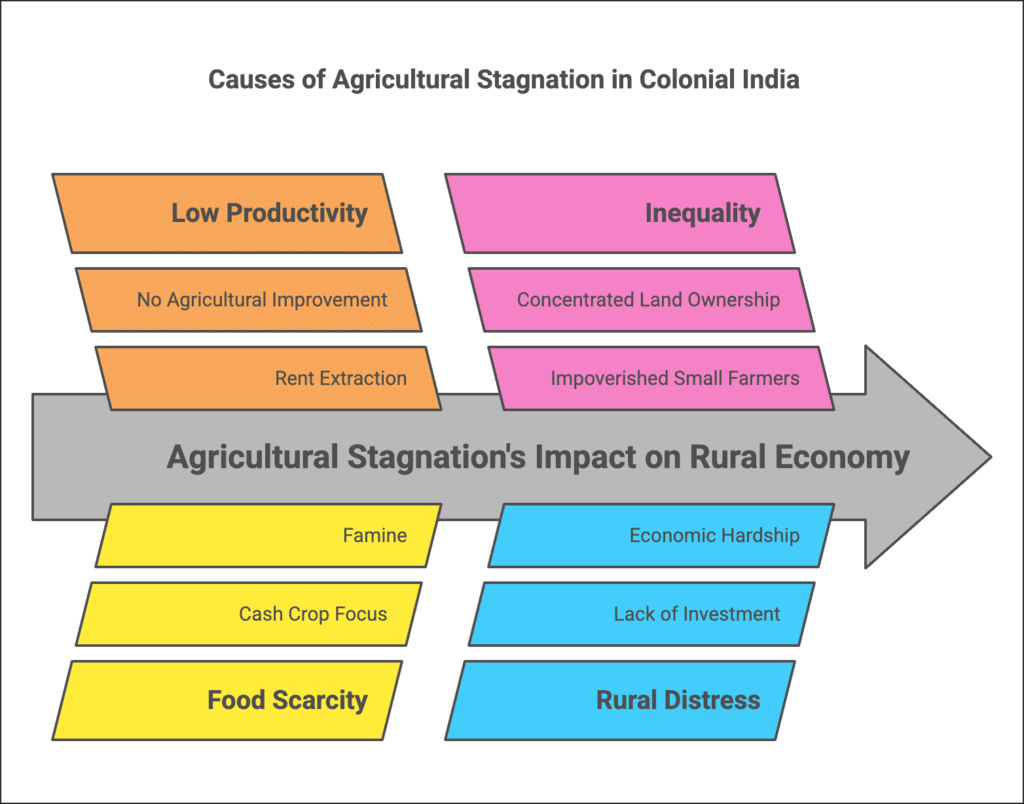Higher Order Thinking Skills - Indian Economy On The Eve Of Independence | Economics Class 12 - Commerce PDF Download
Q1: The colonial government’s focus was on transforming India into a supplier of raw materials and a market for British goods. Critically assess how this economic policy shaped India’s industrial backwardness by 1947. Propose a strategy that an independent India could have adopted in 1947 to reverse deindustrialization and evaluate its potential impact on employment and GDP growth.
Ans:
Impact of Colonial Policies on India’s Industrial Backwardness
The colonial government transformed India into a supplier of raw materials and consumer of British goods, leading to deindustrialization by 1947:
- Decline of Handicrafts: Cheap British machine-made goods destroyed India’s handicraft industries, causing unemployment and rural poverty.
- Weak Industrial Base: The colonial regime stifled modern industries, leaving no significant capital goods sector. Emerging industries like textiles and jute remained limited in scale.
- Export-Oriented Agriculture: Focus on cash crops (e.g., cotton, indigo) over food crops caused stagnation in agriculture, frequent famines, and rural distress.
- Colonial Infrastructure: Railways and roads were designed for resource extraction, not domestic growth, leaving inadequate industrial infrastructure.
- Drain of Wealth: Export surpluses financed British expenses, leading to underinvestment in India’s economy.

Proposed Strategy to Reverse Deindustrialization (Post-1947)
To reverse deindustrialization, independent India could adopt:
- Revive Traditional Industries: Provide subsidies, credit, and training to artisans; promote indigenous products globally.
- Build Capital Goods Industry: Invest in heavy industries like steel and machinery to support broader industrialization.
- Promote Import Substitution: Impose tariffs on imports and focus on producing goods locally.
- Invest in Education: Establish technical institutes to create a skilled workforce.
- Boost Agriculture: Shift to food crops, invest in irrigation, and improve productivity to ensure rural stability.
- Develop Infrastructure: Expand roads, railways, and electricity to connect rural areas and support industries.
Impact on Employment and GDP Growth
- Employment: Reviving traditional industries and creating manufacturing units would generate jobs, reducing unemployment. Skill development would aid workforce transition.
- GDP Growth: A diversified industrial base and self-reliance through import substitution would boost GDP, stabilize trade, and raise rural incomes.
- Long-Term Benefits: Investments in education and infrastructure would sustain growth, transitioning India from an agrarian to an industrialised economy.
Q2: Reflect on the occupational structure’s rigidity, with 70-75% of the workforce in agriculture, and the lack of industrial growth in India by 1947. Assess whether British colonial policies or local conditions were more responsible for this economic imbalance, using evidence from the document to support your analysis.
Ans: By 1947, India’s workforce was 70-75% agricultural, with manufacturing and services lagging at 10% and 15-20%, respectively. This imbalance reflected agricultural stagnation and industrial underdevelopment.
Role of British Colonial Policies
British policies prioritised Britain’s economic interests over India’s development:
- Deindustrialization: Cheap British goods destroyed India’s handicraft industries, leaving no modern industrial base.
- Agricultural Exploitation: The Zamindari system extracted rents without reinvesting in agriculture, causing low productivity and rural poverty.
- Trade Orientation: India exported raw materials and imported finished goods, stifling domestic industries.
- Infrastructure for Extraction: Railways and roads facilitated resource extraction, not balanced development.
Role of Local Conditions
Local factors also contributed but were secondary:
- Traditional Agrarian Economy: Pre-British India was predominantly agrarian, making industrialisation harder.
- Lack of Capital and Technology: Limited capital goods and technology hindered rapid industrialisation.
- Social Structure: Rigid caste systems restricted occupational mobility.
Conclusion
While local conditions influenced rigidity, British policies were primarily responsible for the economic imbalance by stifling industrial growth, prioritising raw material extraction, and neglecting agriculture. These actions entrenched India’s dependence on agriculture and left industries underdeveloped.
Q3: Agricultural stagnation under colonial rule was exacerbated by the Zamindari system and lack of investment, as per the document. Analyse the long-term effects of this stagnation on India’s rural economy at independence. Suggest a land reform model to redistribute resources, boost productivity, and predict its social and economic consequences by 1960.
Ans:
Long-Term Effects of Agricultural Stagnation
Agricultural stagnation under colonial rule, worsened by the Zamindari system and lack of investment, severely impacted India’s rural economy by 1947:
- Low Productivity: Zamindars extracted rents without improving agriculture, leading to poverty.
- Food Scarcity: Focus on cash crops caused famines and malnutrition.
- Inequality: Land ownership was concentrated, leaving small farmers impoverished.
- Rural Distress: Lack of irrigation and tools perpetuated poverty and indebtedness.

Proposed Land Reform Model
To address these issues, India could adopt:
- Abolish Zamindari: Transfer land ownership to tillers.
- Redistribute Land: Impose ceilings and allocate surplus land to landless labourers.
- Tenancy Reforms: Secure tenant rights and regulate rents.
- Invest in Infrastructure: Develop irrigation, modern techniques, and credit access.
- Promote Cooperatives: Encourage cooperative farming for small farmers.
Predicted Consequences by 1960
- Economic Growth: Higher productivity would reduce food scarcity and support industrialisation.
- Poverty Alleviation: Land redistribution would improve incomes and reduce inequality.
- Social Stability: Removing zamindars would weaken feudal structures and reduce unrest.
- Employment: Investments in agriculture would create rural jobs and reduce urban migration.
Challenges included resistance from large landowners and administrative limitations. By 1960, these reforms could lay the foundation for a more equitable and productive rural economy, aligning with India’s development goals.
Q4: Consider the systematic deindustrialization of India’s handicraft industries and the limited growth of modern industries by 1947. Evaluate whether the British motive to create a raw material supplier or their suppression of industrial competition was more responsible for India’s industrial backwardness, using document details to justify your stance.
Ans: The systematic deindustrialization of India’s handicraft industries and the limited growth of modern industries by 1947 can be attributed more to Britain’s suppression of industrial competition than their aim to create a mere supplier of raw materials. While resource extraction played a role, the deliberate destruction of India’s traditional industries and the prevention of industrialization were central to maintaining Britain’s economic dominance.
Suppression of Handicraft Industries
British policies deliberately undermined India’s world-famous handicraft industries to eliminate competition for British manufactured goods. For instance:
- Flooding the Market: Cheap, machine-made British textiles were imported into India, destroying the domestic textile industry. Artisans producing cotton and silk textiles, once renowned globally, faced ruin as they could not compete with the low-cost imports.
- Loss of Global Reputation: These industries had previously enjoyed a strong international reputation for high-quality craftsmanship. However, British policies dismantled this competitive edge, leaving artisans unemployed and traditional skills eroded.
The intent was not merely to exploit India’s raw materials but also to suppress any potential industrial competition that could challenge Britain’s manufacturing supremacy.
Neglect of Modern Industrial Growth
The colonial government actively hindered the development of modern industries in India:
- Lack of Capital Goods Industry: No significant investment was made in capital goods industries, such as machinery production, which are essential for industrial expansion. This left India dependent on imports of tools and equipment.
- Infrastructure for Extraction: Infrastructure like railways was developed solely to extract resources and facilitate exports, not to support industrial growth or domestic markets.
- Stunted Growth of Modern Industries: Even when modern industries emerged in the late 19th century, their growth remained slow due to limited support, restricted access to advanced technology, and unfavourable trade policies.
Q5: Reflect on India’s demographic challenges, such as low literacy and high mortality rates, alongside its economic stagnation at independence. Evaluate whether social underdevelopment or colonial economic exploitation posed a greater barrier to India’s growth potential in 1947, using evidence from the document to substantiate your reasoning.
Ans:
Demographic Challenges
India in 1947 faced severe demographic challenges, reflecting deep social underdevelopment:
- Low Literacy Rates: Overall literacy was less than 16%, with female literacy at a negligible 7%.
- High Mortality Rates: Life expectancy was only 32 years, and infant mortality stood at 218 per thousand.
- Widespread Poverty: Large sections of the population lived in extreme poverty, compounded by inadequate public health facilities and rampant malnutrition.
Simultaneously, economic stagnation was evident due to colonial exploitation, which transformed India into a supplier of raw materials and a consumer of British goods, leaving its agricultural and industrial sectors underdeveloped.
Colonial Economic Exploitation as the Root Cause
While both social underdevelopment and colonial economic exploitation posed barriers, colonial economic exploitation was the more fundamental obstacle to India’s growth potential. Key factors include:
1. Deindustrialisation:
- Traditional handicraft industries, once globally renowned, were destroyed by British policies that flooded Indian markets with cheap manufactured goods.
- This left no modern industrial base to replace the declining traditional industries.
2. Agricultural Stagnation:
- Agriculture, employing 70-75% of the population, suffered from low productivity due to inadequate irrigation, technology, and fertilizers.
- Export-oriented commercialization diverted resources away from food crops, causing famines and worsening demographic indicators like mortality rates.
3. Neglect of Capital Goods Industries:
The lack of investment in capital goods industries hindered industrial expansion, leaving India dependent on imports for machinery and tools.
Interconnection Between Social and Economic Issues
Social underdevelopment, such as illiteracy and poor health, hindered human capital formation. However, these issues were partly a consequence of economic exploitation:
- Stagnant incomes and scarce resources left little room for investments in education or healthcare.
- Poverty perpetuated by economic stagnation worsened social conditions, creating a vicious cycle.
|
64 videos|308 docs|51 tests
|
FAQs on Higher Order Thinking Skills - Indian Economy On The Eve Of Independence - Economics Class 12 - Commerce
| 1. What was the state of the Indian economy on the eve of independence in 1947? |  |
| 2. How did British colonial policies impact the Indian economy before independence? |  |
| 3. What were some of the key features of the Indian agricultural sector on the eve of independence? |  |
| 4. What were the major economic challenges India faced immediately after gaining independence in 1947? |  |
| 5. How did the economy of India evolve in the years following independence? |  |





















